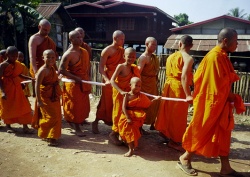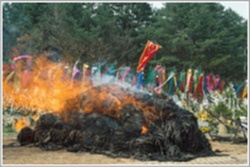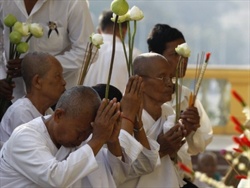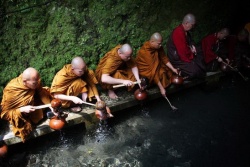What to expect if you are invited to a Thai Funeral
The longer that you stay in Thailand, the higher the chance is that you will one day be invited to a funeral. This might be for the parent of a colleague at work or a relation of your Thai wife or husband. I am not exactly an expert on Thai funerals, but I have attended a fair number. I have also been invited, strange as it may seem, to take pictures at funerals. Like this group photo in the first picture. For this particular funeral I had to take dozens of pictures of various groups posing in front of the coffin of the deceased.
If you are invited to a funeral, then the first question that might go through your mind is what to wear. As you can see from this photograph, you should wear either black or white or a combination of the two. You should avoid any bright colours but you could get away with it if it is a muted colour. For example, I have seen some people wearing blue jeans but with a white or black polo shirt. For myself I usually wear a white shirt and black tie for the main events and a black polo shirt for other times. Funerals for Thai Buddhists can go on for much longer than what you may have seen before in the West. It could last from anything from one week to a year or two. Depending on how close you were to the deceased, you probably won’t be expected to attend every part of the funeral. For the parents of colleagues at work I probably would only attend the cremation on the last day. For relations of friends you probably would attend at least one if not all of the chanting sessions. If you are close to the family then it might be appropriate for you to bring a wreath. Either that or give the family some money in an envelope.
The Bathing Rite takes place on the evening of the first day. You would only attend this if you knew the deceased personally. The body is laid out on a table and covered with a cloth. Only the head and the right hand is showing. People then take turns to pour some scented water over the exposed hand. You can take this opportunity to make a blessing or to ask for forgiveness for past misdeeds. A sacred white string, called sai sin, is then tied around the ankles and wrists. The hands are held together in a prayer-like gesture holding a lotus flower and incense sticks. A coin is also put in the mouth.The body is then placed in a coffin and placed on a high table. It is then surrounded by flowers. A portrait of the deceased is also prominently displayed. Four monks are then invited to chant daily for the deceased. This usually take place over a period of seven days. However, this might be shortened if the cremation needs to take place on a certain day, like the weekend. It also should be noted that cremations cannot take place on Fridays as the name for that day sounds like the Thai word for “happiness”. If the chanting sessions are shortened to say five days, the same amount of merit still needs to be created for the deceased, so on two nights the chanting sessions have to be done twice. Notice the ribbon in this photograph. It goes all the way to the coffin which is how the deceased receives the merit.
In Bangkok, the daily chanting sessions for the deceased will probably start at 7 p.m. and last for about an hour. Upcountry these are often done at the house and may go on all night as they are social events. It is not a completely sad affair. There are four main chants with regular breaks in-between. During the breaks people chat or listen to some traditional Thai music. There is also often a break with some Thai dancing. The hosts are always generous and you will find that you are also given drinks and snacks. Even full meals. Before my first chanting session I thought I would have to sit on the floor for hours. But, there are always seats and the time passes quickly. After seven days of chanting the cremation can take place. Some families will do this straight away while others might wait a year or more. Quite often a young family member, usually the grandson, will ordain as a novice monk in order to make merit for the deceased. They do this for only a day or two. Even though it is only for a short time, they still have to do the full ordination which includes the shaving of hair and eyebrows. On the morning of the cremation there is more chanting and food is then offered to the monks. Once everyone has eaten, it is time to move the coffin to the crematorium. The coffin is carried outside and placed onto an ornate cart. A procession then takes place to the crematorium. Leading the way are family members carrying a portrait of the deceased. Behind them are a couple of monks holding onto a white thread that is attached to the coffin. The mourners walk behind the coffin. If you have ever done a procession around a chapel at a Thai temple on a Buddhist holiday you know that you have to walk around it three times in a clockwise direction. However, for funerals, you must walk anti-clockwise.
The coffin is then taken up the steps and placed on a high table in front of the crematorium doors. The portrait of the deceased is also placed here. The crematorium itself is decorated during the afternoon with black and white cloth and beautiful flowers which were the favourites of the deceased. The cremation ceremony is often in the late afternoon. If you didn’t go to the Bathing Rite or any of the nightly chanting then the cremation ceremony is the one that you should really attend. At cremations you don’t get to see much of the ceremony. Most people are seated far away. During the ceremony, honoured guests will come forward with monk robes and place them on a pedestal in front of the coffin. As you can see here, the same ribbon is being used to connect the pedestal to the coffin. A monk then comes to receive the robe as if it was offered by the deceased. The monk here is saying a prayer before receiving the robe. During the ceremony someone will also give an eulogy about the life of the deceased. There is often also some kind of traditional dance performance.
Cremation ceremonies are often over very quickly. Anything from 30 minutes to an hour. When you arrive you are given a flower made from wood shavings. You will need this for the last part of the ceremony. The monks at the cremation will go up the steps first with their “flowers”. These are placed under the coffin as if you were lighting the funeral fire. Once all of the monks have done this then it is the turn of the guests. What most people do is tap the coffin a couple of times with the flower then place it in a tray under the coffin and then give a quick “wai”. You are also supposed to say a short prayer telling the deceased person that you forgive them for any wrong doings in the past. On your way down, you will be given a kind of souvenir of the funeral to take home. Sometimes this a book about the life of the deceased person.
At this stage, most people would go home. They have paid their respects. Unless you were close to the deceased, you would go home too. It is mainly family members that stay for the actual cremation. What happens first is that the ornaments decorating the coffin are removed. The coffin is then lifted off its base and then carried towards the crematorium oven. The lid is then taken off. A coconut is cut open and the juice poured over the deceased person. The coffin is then pushed inside the chamber. This is the last chance for family members to pay their respects. The remaining sandalwood flowers are also thrown into the coffin. Everyone then goes down to the bottom of the steps where they gather around to watch the cremation. At some funerals I have attended, rockets are fired into the sky. However, this is banned in residential areas. The friends and relations don’t wait for the fire to finish. They will come back the next day to collect the ashes. A monk is present for this ceremony. Sweet smelling flower petals are mixed in with the ashes. Depending on the family, these might be placed in one urn or several. Once they are collected they are taken to the prayer hall where there is more chanting and robes and food are again presented to the monks on behalf of the deceased. What happens next to the ashes will vary. Most will keep the ashes at the temple as there will be further merit making ceremonies on the 50th and 100th days. Some people keep them at their home.
A third option, which is seemingly becoming more popular these days, is called “loi angkarn” which means the floating or scattering of ashes over the water. However, they might keep some relics, like pieces of bone, in the shrine at home. It is not really a Buddhist tradition as it has been adapted from Hinduism where they often scatter ashes in the Ganges River. Some Thai people believe that floating the ashes of their loved ones in a river or in the open sea will help wash away their sins but also help them go more smoothly up to heaven. It doesn’t matter where you do this, but if you are in the Bangkok and Samut Prakan area then an auspicious place is the mouth of the Chao Phraya River at Paknam where I live. There are a set number of rituals that have to be done in the correct order before the main ceremony. This includes paying respect to the guardian spirit of the boat and then later the god of the ocean and the goddess of water. Next comes the prayers where the mourners request the spirits and gods to look after the deceased person. It is then time for the white cloth containing the ashes to be carefully dropped over the side. They don’t actually scatter the ashes, they just let the cloth float away and then sink. As they watch it go, they say their final farewells while at the same time scattering flower petals on the water.



